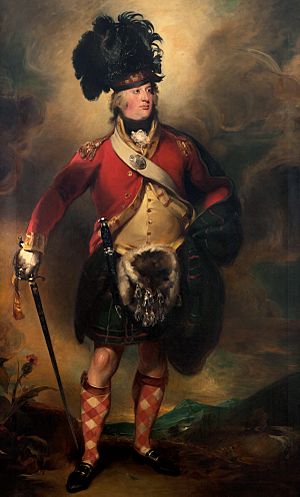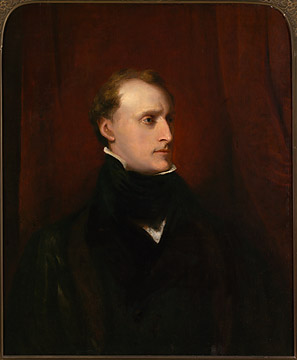Francis Mackenzie, 1st Baron Seaforth facts for kids
Quick facts for kids
Francis Mackenzie, 1st Baron Seaforth
|
|
|---|---|

Lord Seaforth by Sir Thomas Lawrence
|
|
| Born | 9 June 1754 |
| Died | 11 January 1815 |
| Allegiance | |
| Service/ |
|
| Rank | Lieutenant-General |
| Battles/wars | French Revolutionary Wars |
Lieutenant-General Francis Humberston Mackenzie, 1st Baron Seaforth (born June 9, 1754 – died January 11, 1815) was an important person in British history. He was a politician, a soldier, and even a scientist who studied plants. He was also the leader, or Chief, of a famous Scottish family called Clan Mackenzie. He helped create a well-known army group called the 78th (Highlanders) Regiment of Foot.
Contents
Early Life and Challenges
Francis Mackenzie was born in 1754. His father was Major William Mackenzie. When Francis was about 12 years old, he got very sick with scarlet fever. This illness caused him to lose his hearing. He also found it very hard to speak. Because of this, people called him MacCoinnich Bodhar, which means "Deaf Mackenzie" in Scottish Gaelic.
In 1783, his older brother, Thomas Frederick Mackenzie Humberston, passed away. This meant Francis became the last male heir of his family's noble title, the Earl of Seaforth.
Political and Military Career
Francis Mackenzie was involved in politics for many years. He served as a Member of Parliament (MP) for the County of Ross. He was an MP from 1784 to 1790, and again from 1794 to 1796.
He was very keen to help his country. In 1787, he offered to create a new army regiment from his own lands. He wanted to lead this regiment himself. The government did not accept his offer at first. But when war started in 1793, they finally agreed. He was given permission to raise a Highland Battalion, which became the famous 78th (Highlanders) Regiment of Foot.
In 1797, he was given a special honor. He was made a nobleman, known as Lord Seaforth, Baron Mackenzie. This title was named after Kintail in the County of Ross.
Governor of Barbados
From 1800 to 1806, Lord Seaforth served as the Governor of Barbados. During this time, he worked to make life better for enslaved people on the island. He made new rules that stopped people from killing enslaved individuals. He also reduced unfair treatment against free Black people. In 1808, he was promoted to Lieutenant-General in the army.
Interests and Contributions
Lord Seaforth had a great interest in science, especially plants. In 1794, he became a member of the Royal Society. This is a very old and respected group for scientists. A type of plant, Seaforthia, was even named after him!
He also became a member of the Royal Society of Edinburgh in 1795. This was also because of his work with plants. He was a member of the Linnean Society too, which focuses on natural history.
Supporting the Arts
Lord Seaforth was also a supporter of artists. In 1796, he gave money to a famous painter named Thomas Lawrence. This helped Lawrence when he was having money problems. Lawrence later painted a beautiful picture of Lord Seaforth's daughter, Mary.
He also asked another famous painter, Benjamin West, to create a painting. This painting showed a scene from Scottish history: "King Alexander III of Scotland being rescued from a stag."
The famous writer Walter Scott said that Lord Seaforth was a very talented nobleman. He believed that Seaforth would have been even more famous if his health problems had not held him back.
Family Life
In 1782, Francis Mackenzie married Mary Proby. Mary was the daughter of Baptist Proby, who was a church leader.
Sadly, all four of Francis's legitimate sons passed away before him. This was a great sorrow for him. During the last two years of his life, he was very sad about losing his sons and rarely spoke.
His children included:
- William Frederick Mackenzie (died young)
- George Leveson Boucherat Mackenzie (died young)
- Hon. William Frederick Mackenzie (died 1814), who was also an MP.
- Hon. Francis John Mackenzie (died 1813), who was a naval officer.
- Hon. Mary Elizabeth Frederica Mackenzie, who inherited her father's property. She married twice.
- Frances Catherine Mackenzie
- Caroline Elizabeth Mackenzie (died in an accident)
- Charlotte Elizabeth Mackenzie (died unmarried)
- Augusta Anne Mackenzie (died unmarried in 1856)
- Helen Anne Mackenzie (married Joshua Henry Mackenzie)



